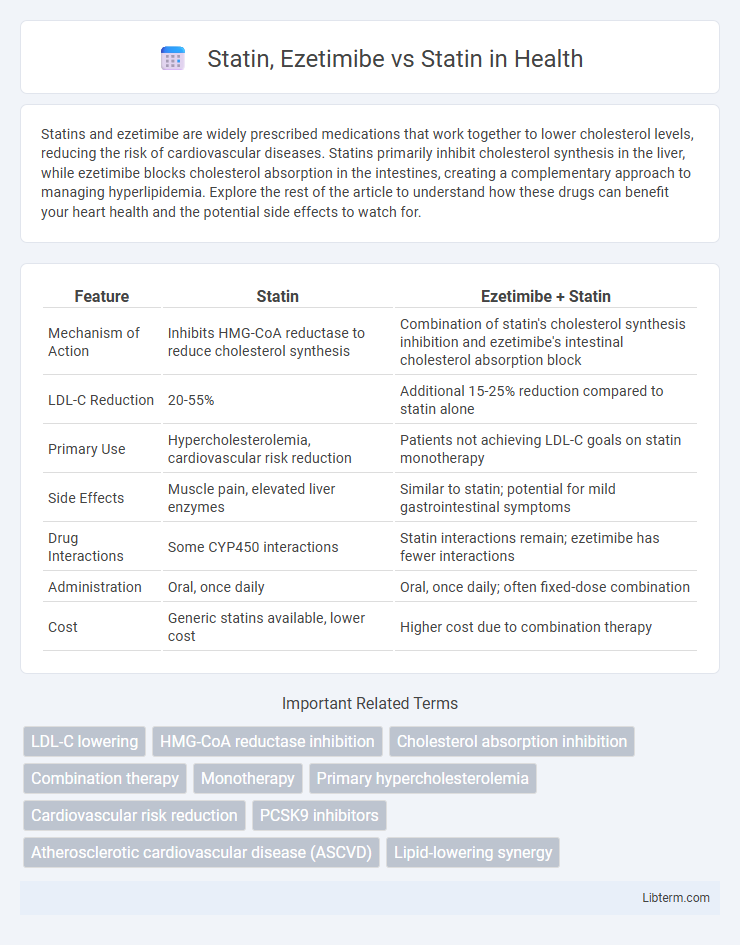Statins and ezetimibe are widely prescribed medications that work together to lower cholesterol levels, reducing the risk of cardiovascular diseases. Statins primarily inhibit cholesterol synthesis in the liver, while ezetimibe blocks cholesterol absorption in the intestines, creating a complementary approach to managing hyperlipidemia. Explore the rest of the article to understand how these drugs can benefit your heart health and the potential side effects to watch for.
Table of Comparison
| Feature | Statin | Ezetimibe + Statin |
|---|---|---|
| Mechanism of Action | Inhibits HMG-CoA reductase to reduce cholesterol synthesis | Combination of statin's cholesterol synthesis inhibition and ezetimibe's intestinal cholesterol absorption block |
| LDL-C Reduction | 20-55% | Additional 15-25% reduction compared to statin alone |
| Primary Use | Hypercholesterolemia, cardiovascular risk reduction | Patients not achieving LDL-C goals on statin monotherapy |
| Side Effects | Muscle pain, elevated liver enzymes | Similar to statin; potential for mild gastrointestinal symptoms |
| Drug Interactions | Some CYP450 interactions | Statin interactions remain; ezetimibe has fewer interactions |
| Administration | Oral, once daily | Oral, once daily; often fixed-dose combination |
| Cost | Generic statins available, lower cost | Higher cost due to combination therapy |
Overview of Statins: Mechanism and Benefits
Statins function by inhibiting HMG-CoA reductase, a key enzyme in cholesterol synthesis, effectively lowering LDL cholesterol levels and reducing cardiovascular risk. This mechanism not only decreases plaque formation but also improves endothelial function and stabilizes existing atherosclerotic plaques. Combining statins with ezetimibe, which blocks intestinal cholesterol absorption, enhances lipid-lowering effects more than statins alone, leading to greater LDL reduction and improved patient outcomes.
Introduction to Ezetimibe: How It Works
Ezetimibe selectively inhibits the Niemann-Pick C1-Like 1 (NPC1L1) protein, reducing intestinal cholesterol absorption and lowering LDL cholesterol levels. When combined with statins, which inhibit HMG-CoA reductase to reduce cholesterol synthesis in the liver, ezetimibe enhances overall lipid-lowering effects more effectively than statin monotherapy. This dual mechanism targets cholesterol reduction through complementary pathways, improving cardiovascular risk management.
Statin Monotherapy: Efficacy and Indications
Statin monotherapy effectively lowers LDL cholesterol levels by 20-55%, with high-intensity statins such as atorvastatin and rosuvastatin providing the greatest reduction. Indications for statin monotherapy include primary and secondary prevention of atherosclerotic cardiovascular disease (ASCVD), familial hypercholesterolemia, and patients with elevated LDL cholesterol not achieving targets through lifestyle interventions. Compared to ezetimibe combination therapy, statin monotherapy remains the first-line treatment due to its proven efficacy in reducing cardiovascular events and mortality rates.
Statin vs Ezetimibe: Mechanistic Differences
Statins primarily reduce cholesterol by inhibiting HMG-CoA reductase, the key enzyme in hepatic cholesterol synthesis, whereas ezetimibe lowers cholesterol by blocking the Niemann-Pick C1-Like 1 (NPC1L1) transporter in the intestinal brush border, preventing dietary cholesterol absorption. The distinct mechanisms result in complementary effects; statins decrease endogenous cholesterol production while ezetimibe targets exogenous cholesterol uptake. This mechanistic difference underpins combination therapy's efficacy for more significant LDL-C reduction compared to either agent alone.
Lipid-Lowering Efficacy: Statin vs Ezetimibe
Statin therapy significantly reduces LDL cholesterol by inhibiting HMG-CoA reductase, achieving reductions of 20-55% depending on the statin and dose. Ezetimibe lowers LDL cholesterol by approximately 15-20% through inhibition of intestinal cholesterol absorption, typically providing modest lipid-lowering efficacy when used alone. Combining statins with ezetimibe enhances LDL cholesterol reduction by an additional 15-25% compared to statin monotherapy, offering superior lipid-lowering efficacy in managing hypercholesterolemia.
Combination Therapy: Statin Plus Ezetimibe
Combination therapy with statin plus ezetimibe significantly enhances LDL cholesterol reduction compared to statin monotherapy, proving especially effective for patients with hypercholesterolemia resistant to single-agent treatment. Clinical trials such as IMPROVE-IT demonstrated that adding ezetimibe to statins lowers cardiovascular events by further inhibiting cholesterol absorption alongside HMG-CoA reductase inhibition. This dual mechanism optimizes lipid control, reduces inflammation, and improves overall cardiovascular outcomes, making the combination a strategic choice in managing atherosclerotic cardiovascular disease.
Cardiovascular Outcomes: Comparative Evidence
Statin therapy remains the cornerstone for reducing cardiovascular events, with extensive evidence demonstrating significant LDL-C reduction and improved cardiovascular outcomes. Ezetimibe added to statin therapy further lowers LDL-C by approximately 20-25%, providing incremental benefits in preventing major adverse cardiovascular events, especially in high-risk patients as shown in the IMPROVE-IT trial. Comparative analyses indicate that while statins alone achieve substantial risk reduction, the combination with ezetimibe offers enhanced LDL-C control and superior event reduction in secondary prevention populations.
Safety Profiles: Statin, Ezetimibe, and Their Combination
Statins are generally well-tolerated but may cause muscle-related side effects and liver enzyme elevations, while ezetimibe has a favorable safety profile with minimal adverse effects, primarily mild gastrointestinal symptoms. The combination of statin and ezetimibe enhances LDL cholesterol reduction without significantly increasing the risk of adverse events compared to statin monotherapy. Clinical trials such as IMPROVE-IT demonstrate that this combination maintains cardiovascular safety while improving lipid-lowering efficacy.
Patient Selection: When to Add Ezetimibe to Statin
Patients with atherosclerotic cardiovascular disease (ASCVD) or those at very high risk who do not achieve LDL-C targets despite maximally tolerated statin therapy should be considered for ezetimibe addition. Ezetimibe enhances LDL-C reduction by inhibiting intestinal cholesterol absorption, providing incremental benefit particularly in individuals unable to tolerate high-intensity statins or with statin-resistant hypercholesterolemia. Clinical guidelines emphasize ezetimibe as the first add-on therapy before considering PCSK9 inhibitors in patients requiring further LDL-C lowering beyond statin monotherapy.
Current Guidelines: Managing Dyslipidemia with Statin and Ezetimibe
Current guidelines recommend combining statins with ezetimibe for patients with dyslipidemia who do not achieve LDL-C targets on statin monotherapy, enhancing cholesterol reduction by inhibiting both synthesis and absorption. Statin and ezetimibe therapy is particularly advocated in high-risk populations, such as those with atherosclerotic cardiovascular disease or familial hypercholesterolemia, to attain more aggressive lipid-lowering goals. Clinical trials demonstrate that this combination effectively reduces LDL-C levels beyond statin alone, improving cardiovascular outcomes with a favorable safety profile.
Statin, Ezetimibe Infographic

 libterm.com
libterm.com